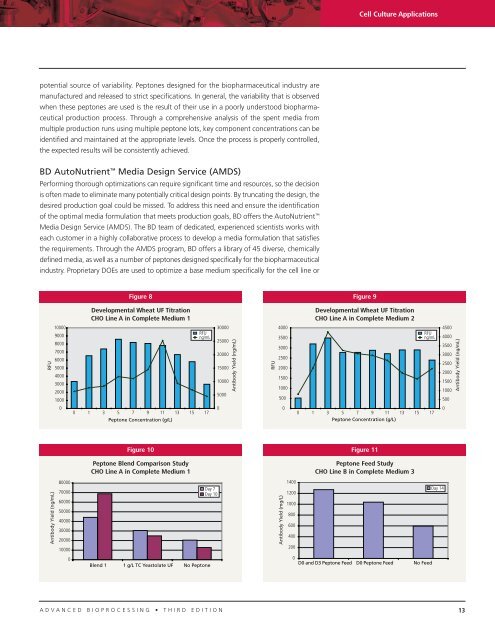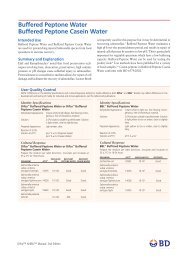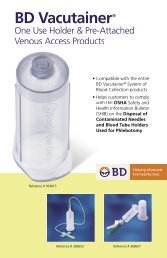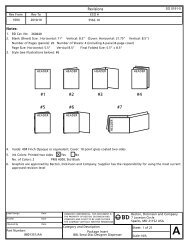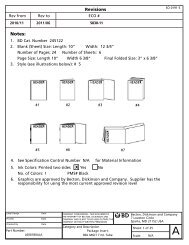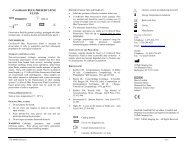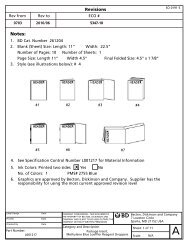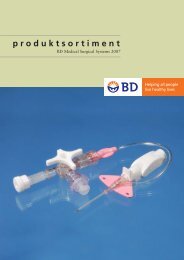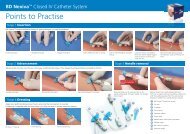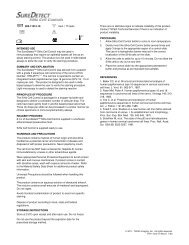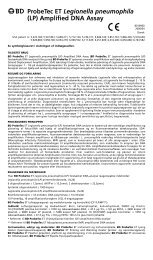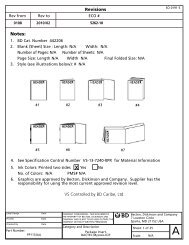You also want an ePaper? Increase the reach of your titles
YUMPU automatically turns print PDFs into web optimized ePapers that Google loves.
potential source of variability. Peptones designed for the biopharmaceutical industry are<br />
manufactured and released to strict specifications. In general, the variability that is observed<br />
when these peptones are used is the result of their use in a poorly understood biopharmaceutical<br />
production process. Through a comprehensive analysis of the spent media from<br />
multiple production runs using multiple peptone lots, key component concentrations can be<br />
identified and maintained at the appropriate levels. Once the process is properly controlled,<br />
the expected results will be consistently achieved.<br />
<strong>BD</strong> AutoNutrient Media Design Service (AMDS)<br />
Performing thorough optimizations can require significant time and resources, so the decision<br />
is often made to eliminate many potentially critical design points. By truncating the design, the<br />
desired production goal could be missed. To address this need and ensure the identification<br />
of the optimal media formulation that meets production goals, <strong>BD</strong> offers the AutoNutrient Media Design Service (AMDS). The <strong>BD</strong> team of dedicated, experienced scientists works with<br />
each customer in a highly collaborative process to develop a media formulation that satisfies<br />
the requirements. Through the AMDS program, <strong>BD</strong> offers a library of 45 diverse, chemically<br />
defined media, as well as a number of peptones designed specifically for the biopharmaceutical<br />
industry. Proprietary DOEs are used to optimize a base medium specifically for the cell line or<br />
RFU<br />
Antibody Yield (ng/mL)<br />
10000<br />
9000<br />
8000<br />
7000<br />
6000<br />
5000<br />
4000<br />
3000<br />
2000<br />
1000<br />
0<br />
80000<br />
70000<br />
60000<br />
50000<br />
40000<br />
30000<br />
20000<br />
10000<br />
0<br />
Figure 8<br />
Developmental Wheat UF Titration<br />
CHO Line A in Complete Medium 1<br />
0 1 3 5 7 9 11 13 15 17<br />
Peptone Concentration (g/L)<br />
Figure 10<br />
Peptone Blend Comparison Study<br />
CHO Line A in Complete Medium 1<br />
RFU<br />
ng/mL<br />
Blend 1 1 g/L TC Yeastolate UF No Peptone<br />
ADVANCED BIOPROCESSING • THIRD EDITION<br />
0<br />
Day 7<br />
Day 10<br />
30000<br />
25000<br />
20000<br />
15000<br />
10000<br />
5000<br />
Antibody Yield (ng/mL)<br />
RFU<br />
4000<br />
3500<br />
3000<br />
2500<br />
2000<br />
1500<br />
1000<br />
500<br />
Antibody Yield (mg/L)<br />
0<br />
1400<br />
1200<br />
1000<br />
800<br />
600<br />
400<br />
200<br />
Cell Culture Applications<br />
Figure 9<br />
Developmental Wheat UF Titration<br />
CHO Line A in Complete Medium 2<br />
RFU<br />
ng/mL<br />
0 1 3 5 7 9 11 13 15 17<br />
Peptone Concentration (g/L)<br />
Figure 11<br />
Peptone Feed Study<br />
CHO Line B in Complete Medium 3<br />
0<br />
D0 and D3 Peptone Feed D0 Peptone Feed No Feed<br />
4500<br />
4000<br />
3500<br />
3000<br />
2500<br />
2000<br />
1500<br />
1000<br />
500<br />
0<br />
Day 14<br />
Antibody Yield (ng/mL)<br />
13


